Day 1 Summary
TheStadiumBusiness Design & Development Summit 2015 kicked off this morning with representatives from over 28 countries around the world.
Visions of the future
To get us underway the opening presentation was delivered by David Goldstone, Chief Executive of the London Legacy Development Corporation (LLDC).
Since London won the bid for the 2012 Games in 2005, the Olympic Stadium and its post Games use has remained a constant in the news and Goldstone gave an insight into the works that have taken place so far and what remains to be done before the project is complete.
The most prominent change to the stadium’s appearance is the new roof. The new structure has been built to meet strict UEFA and IAAF requirements that require cover over all seats and is twice the size of original. It is now the largest of its kind in the world at 45,000 sqm in size and uses 8km of steel cable to support its 9,900 roof panels.

Above the roof, the fourteen iconic lighting paddles used during the Olympics might look similar, but all have been removed, strengthened and re-installed.
“The roof was a massive challenge and has driven the timetable for the other works” added Goldstone and these have included the addition of a retractable lower tier of 21,000 seats that allows three different modes of seating to be used, giving an 80,000 capacity for concerts, 60,000 for athletics and 54,000 for football and rugby.
Major improvements have also been made to spectator and hospitality facilities in permanent structures that include 16 executive boxes, 3,600 corporate seats and 428 wheelchair spaces, as well as catering outlets and toilets.
With the roof and seating complete, work on the Stadium’s refit were paused recently for a series of events that have included athletics, the Rugby Union World Cup, Rugby League and the upcoming Race of Champions motorsport extravaganza.
In all, more than half a million spectators will have visited the stadium this year, before work re-commences next month on fitting out the hospitality areas, installing both a new athletics track, a new pitch and other landscaping.
Next onto the podium was David Manica, whose presentation on the proposed new LA Stadium was the first of a series looking at some of the industry’s most exciting ‘Visions of the Future’.
Manica gave the audience an insight into the changing nature of the project which has seen the design evolve and transform since the turn of the year, not least because it now has to satisfy two potential clients, the Chargers (who were involved at the beginning) and the Raiders.
The first design was characterised by a 5 storey Suite tower, with the bowls design shaped to reflect the sound from the surrounding general seating areas. Other key features outside the bowl placed an emphasis on sustainability, including a full size pitch for community use that could be transformed into a space for sponsor pavilions on a game day. With tailgating being such an important part of the NFL experience, greenery and landscaping were also predominant in the parking areas, “putting the park back into the parking lot”.
Any 50/50 owner of a stadium wants an input into their venue, so when the Raiders joined the project in April 2015 it meant a redesign for Manica. The latest renders where unveiled at the Summit and showed the stadium as a more homogenous bowl, with the suites integrated into both sides of the stadium.
One of the key features was the addition of a Cauldron, a throwback to the Raiders previous home at the LA Memorial Coliseum and because the building has to change in appearance for the two teams, Manica envisages this to change into a lightning bolt for Chargers games.
In terms of numbers, the redesigned stadium will seat 65,000 – expandable to 80,000 for a Super Bowl – with around 220 suites and a host of bespoke corporate areas designed to be ‘uniquely LA’.
Highlighting the truly global nature of the summit, Hong Kong’s proposed Kai Tak Stadium was next on stage. Linda Law – Principal Assistant Secretary (Recreation & Sport), Home Affairs Bureau of Hong Kong – gave a detail insight into the planning and infrastructure improvements that the former international airport site has undergone.
The works have seen the addition of new roads and train links ready for the next phase of the project, where a consortium will be chosen, covering all aspects of the project – the design, build and running of the stadium.
For the Government the site has to deliver three main objectives; to promote sport in the community to support elite sport; and to make Hong Kong a centre for major international sports events.

To do that, the 28 hectare site will include commercial areas, retail, office space and a hotel, as well as three major sports facilities – a 50,000 seat main stadium that will include a retractable roof to aid with cooling for spectator comfort, a 5,000 seat public sports ground that will include a running track and a 5,000 seat indoor sports centre.
Further sporting elements are included in the 7 hectares of public space and parks that are a key part of the project, including sports courts and a cycle track.
From Asia, the conference moved to the Middle East, and one future project that will be at the forefront of design and construction over the next few years will be the Qatar 2022 World Cup. Abdulaziz Al-Mawlawi – Technical Manager for the Supreme Committee for Delivery & Legacy Qatar – gave an update to the audience on all the latest developments.
To date the designs of five stadiums have been confirmed including four new-builds, the 60,000 seat Al Bayt Stadium and 40,000 seat Al Wakrah Stadium, Qatar Foundation Stadium and Al Rayyan Stadium.
Each stadium design has been inspired by elements of the country’s culture or past, and most will reduce in capacity in legacy mode, with the seats from the upper tiers being sent to developing nations in need of sports infrastructure.
The fifth stadium to be featured was the current national stadium, the Khalifa International Stadium, which will be substantially renovated in time to host 2019 IAAF World Championships.
Other key features highlighted during the presentation included the minimal environmental impact of the new stadiums, with an emphasis on energy efficient cooling technology, a minimised carbon footprint, and energy use best practices.
The need for extensive transport links and multiple journeys is also reduced, with the compact nature of the country allowing people to attend more than one game in a day and stay in the same accommodation throughout the tournament.
Technology Matters
Session 2 of the conference saw the emphasis shift to ‘Why Technology Matters’ in Stadiums, and began with a showcase of the new stadium currently being built for the MLB’s Atlanta Braves.
The presentation was led by Derek Schiller – EVP Sales & Marketing for the Braves – who outlined that the $500 million development is much more than just a stadium and includes an office building, hotel, around 60 retailers, 20 restaurants and 550 residences.

Building the whole project simultaneously has allowed the Braves – in conjunction with marketing specialists Van Wagner – to use technology to integrate partnerships across the whole development after a deal was signed with Comcast to provide ultra fast fibre connectivity.
Bob Jordan – SVP Team & Venue Services for Van Wagner – outlined the benefits this can bring with some 9-10 million visitors a year expected to pass through the stadium and the development.
The use of technology to change the way our stadiums have evolved safely was the key message from André Leitão, Business Development Manager of Bosch Security Systems, The Netherlands.
Bosch have been involved in the technology of over 1000 stadium projects worldwide, covering 80% of all major venues, and their involvement has led to advances in CCTV, turnstiles and ticketing, areas that are vital for delivering a safe stadium today.
Leitão also showcased some exciting developments for the future, including 3D stitching which will allow all CCTV cameras to be displayed on one screen and will shortly be in use at the Philips Stadium in Eindhoven.
Looking ahead, he suggested the focus must be on the integration of technology, using the example of retractable roofs and how we can integrate areas such as the sound system and the HVAC to adapt automatically to the changing conditions.
The final presentation on Technology started the afternoon session, with George Vaughan – Senior Project Manager at RFU Twickenham – outlining the transformation technology and the addition of a contactless POS system has made to the venue.
Not only has the installation of the system cut transaction times from around 15 seconds for a cash sale to just 2 seconds for contactless, but the technology has led to increased sales, particularly in hospitality which has seen a 45% increase since November 2014.
Twickenham’s IPTV system has also been integrated into the system, directing customers away from busy kiosks to less crowded areas on the concourse and looking ahead the stadium will be adding contactless into its hawking and programme booths, which are outside the bowl, in 2016.
Innovation Showcase #1
From Technology the summit moved on to the Innovations Showcase, which featured a selection of the latest product and service innovations for the stadium sector. Based on the popular pecha-kucha format, each speaker had less than seven minutes to get their ideas across.
- Daktronics, the world leader in LED video displays have 30% of the global market share and it’s a position they certainly intend to keep, Ivan Del Rio told the room they have invested $24USD on R&D during the last year alone.
- Iain Macrae, Head of Global Lighting Applications at Thorn Lighting showcased the way that modern stadium LED lighting can help ‘bring some theatre’ to big events.
- French 3D modelling experts PACIFA decision produce high quality 3D renderings of seating charts and corporate facilities at many of Ligue 1’s top clubs and Julien Piwowar closed his speech with a powerful message “3D seating allows customers to see exactly their seat and view at what price. Revolutionary”.
- Mike Crossley spoke on behalf of Lindner and gave us an insight into the results of explosive testing on building materials and how they develop ways to reduce the impact of shrapnel and materials causing harm.
- Scott Kent from SPS Terraces showcased his companies Sandwich Plate System of terracing and he demonstrated its effectiveness with a timelapse video showing terracing for 16,000 seats being installed in just 2 and a half weeks.
- Ticketing3D showcased their recent work at Wembley where they created models to show the impact of different events on the venues seating configurations and also at Manchester City’s Etihad Stadium, where their modelling proved to be a valuable tool for planners and supporters during the stadium’s recent expansion.
- German company Stechert closed the session with a look at their seating products, many of which were added to venues across Germany, England and in Bulgaria over the summer.
The Perfect Partnership
The showcase was followed by a lively 45 minute debate looking at the impact of integrating hotels into stadium development. The panel were hosted by Daniel Gidney – Chief Executive of Lancashire County Cricket Club – whose venue, Emirates Old Trafford, will soon commence building work on a new 150 room Hilton Garden Inn.
David Mann – Chief Executive of The Ageas Bowl – gave his insight from a venue that has recently completed a 171 room Hilton. The hotel was part of a wider redevelopment that includes a spa, a restaurant – Beefy’s – that was developed in conjunction with Ian Botham and an 18-hole golf course that will be completed in 2017.
Representing the Hotel industry were Robert Crook, Managing Director of Interstate Hotels & Resorts and Nick Smart, Vice President N&W Europe for Hilton Worldwide.
Several key messages came out from the debate including the need for joined up thinking between the stadium owner and the hotel group, with communication throughout the process from concept, through feasibility, planning, design, construction and delivery being key.
The size of a particular development is also largely determined by the brand chosen for a hotel. Budget brands tend to be more cost effective with around 100 rooms, but a high end brand which includes conferencing and banqueting facilities will need around 200 rooms to cope with the added infrastructure and numbers needed to host events.
Two new arenas – Unique surrounding districts
The day’s final presentation was given by HOK Senior Project Designer Ryan Gedney, who looked at the challenges of integrating a new 19,000 seat Arena into its surrounding urban district.
The first of two projects he showcased was Rogers Place in Edmonton, Canada. The venue is currently under construction and includes an open Plaza for entertainment, office, retail, residential and parking alongside a new venue for the Edmonton Oilers NHL franchise.
With a major highway dissecting the site and cold weather elevated pedways adding a second level of ‘traffic’ to the area, the Arena’s design incorporates bridges that form parts of the buildings and link the new elements together.
The second showcase was the new NHL Arena that is scheduled to be built in The District of Detroit. Here Gedney’s team have tried to bring ‘The District’ back into the venue by reducing the Arena’s footprint, with 50% of the concourse franchises facing out onto both street and Arena so they can be used every day and not just at game time.
They have also tried to incorporate some of the spirit of the older hockey venues into the design while balancing the demands of modern venues with premium seating and suites. For urban districts, it’s all about the balance between old and new.
Thank you for joining us and we will be bringing you a summary of Day Two tomorrow.
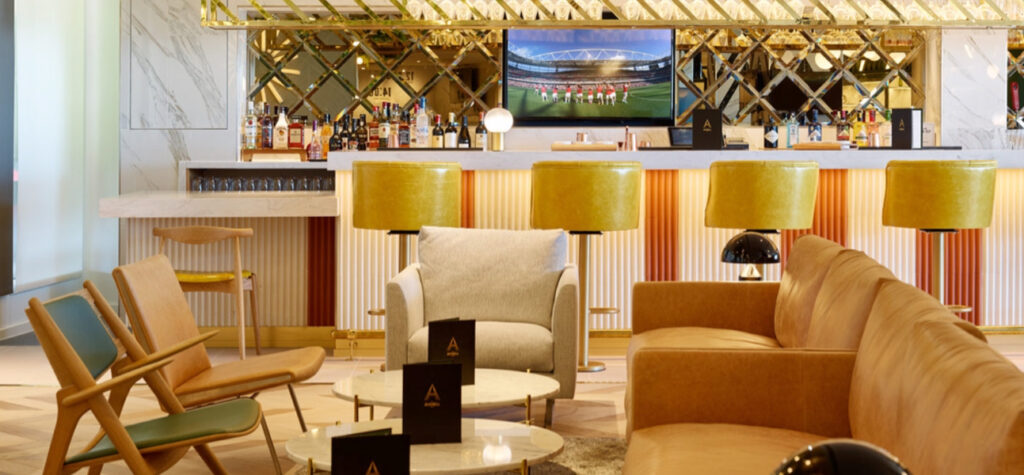
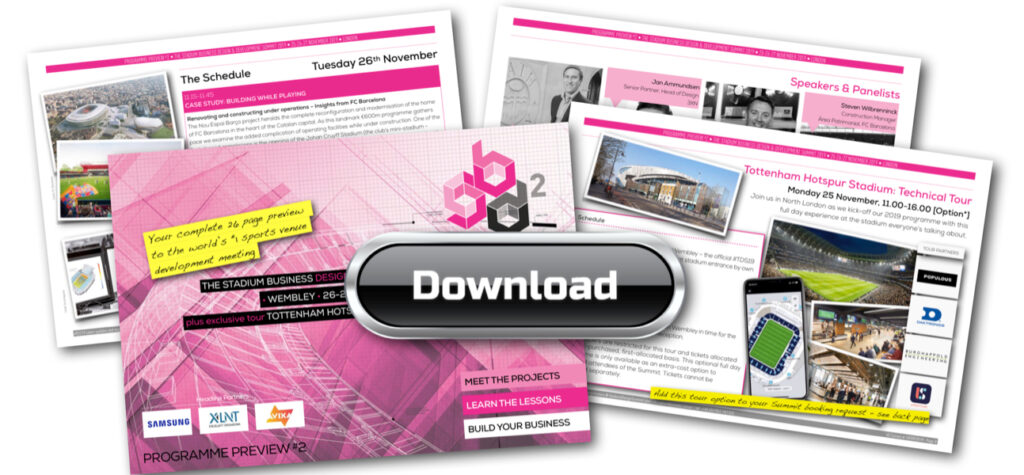


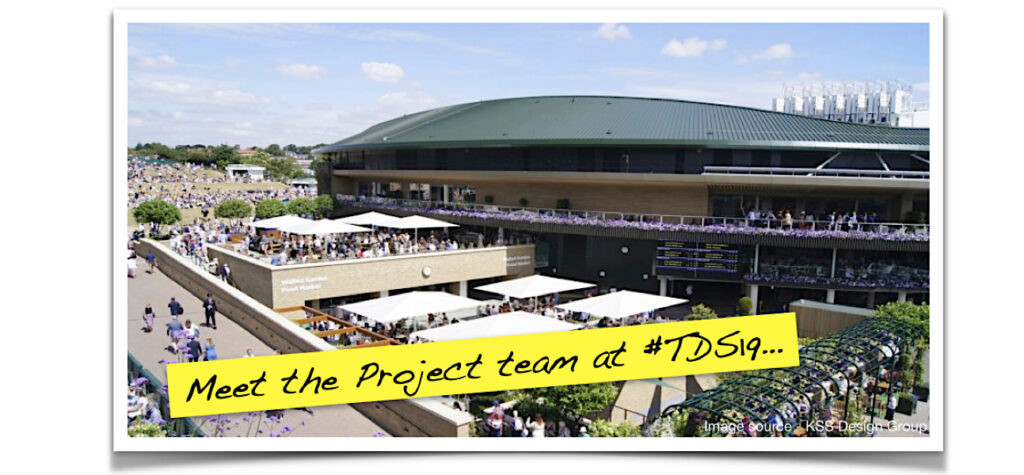
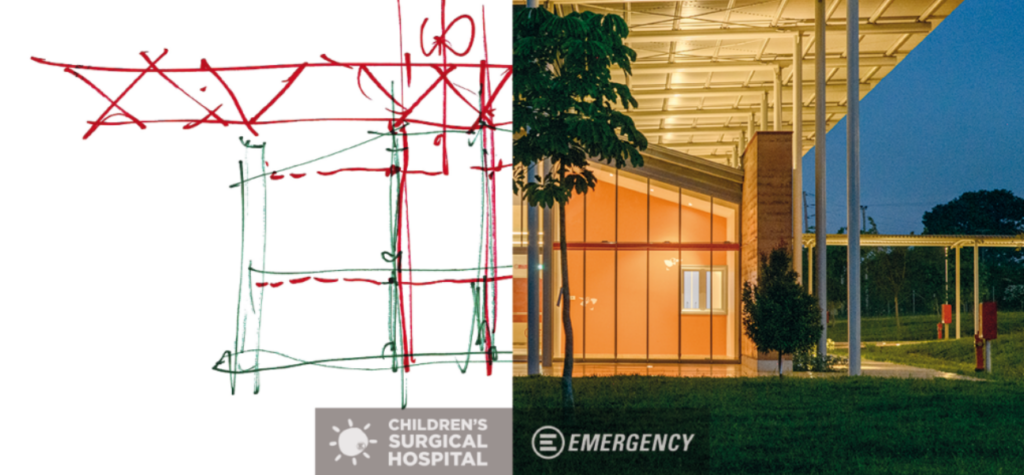
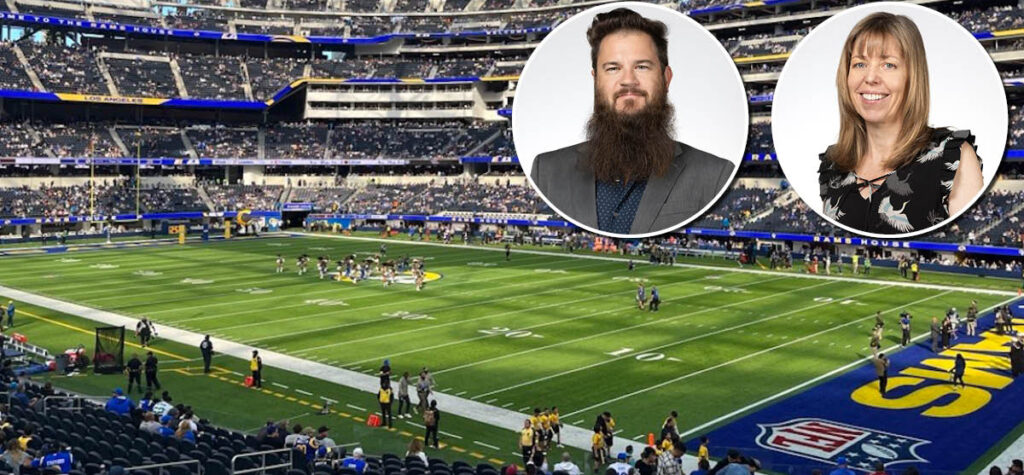
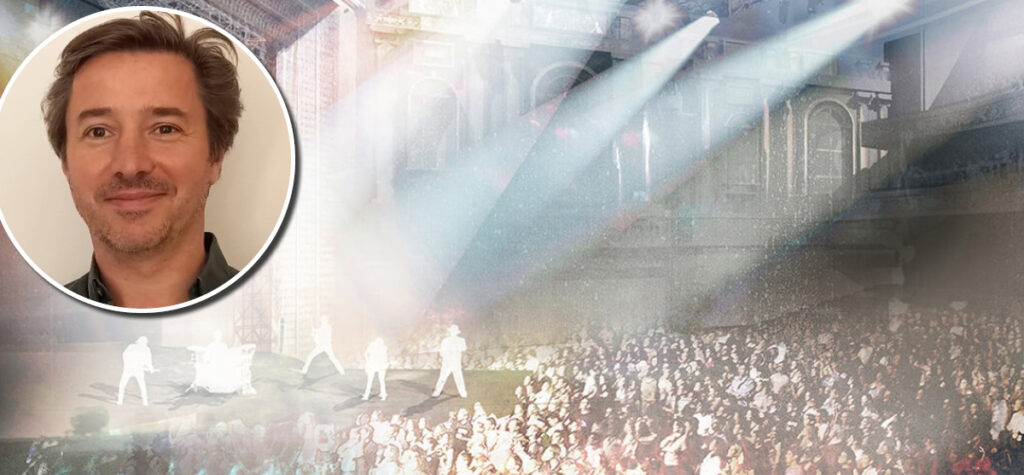
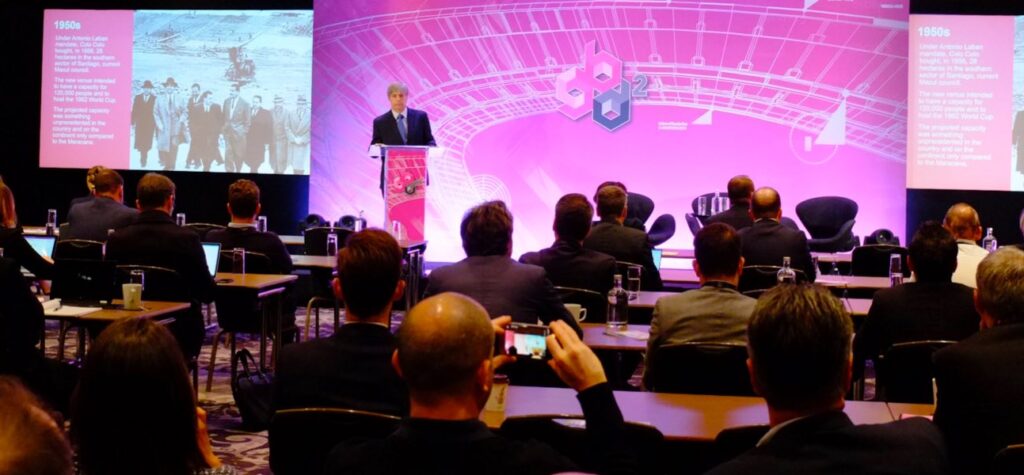
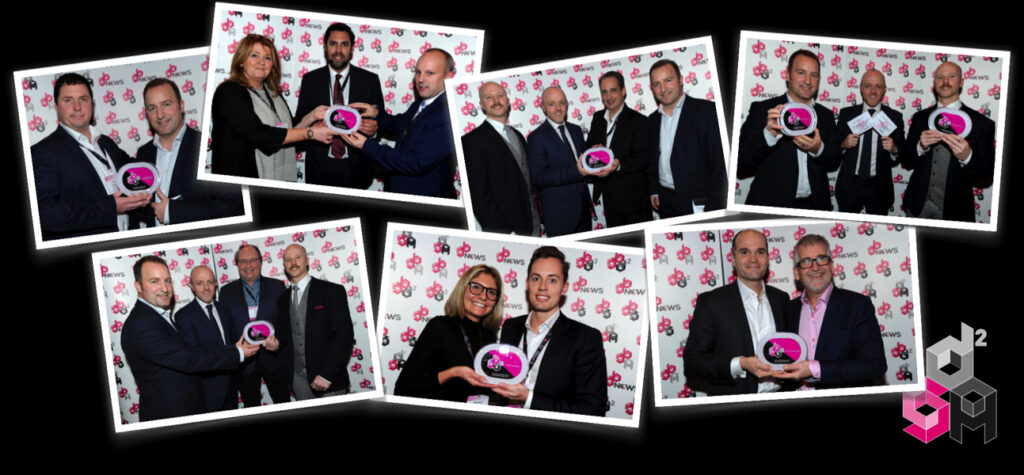
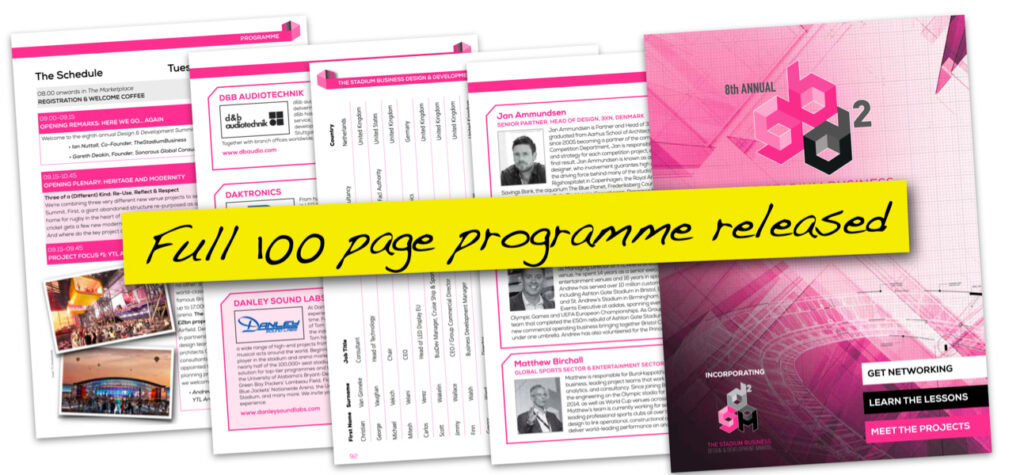
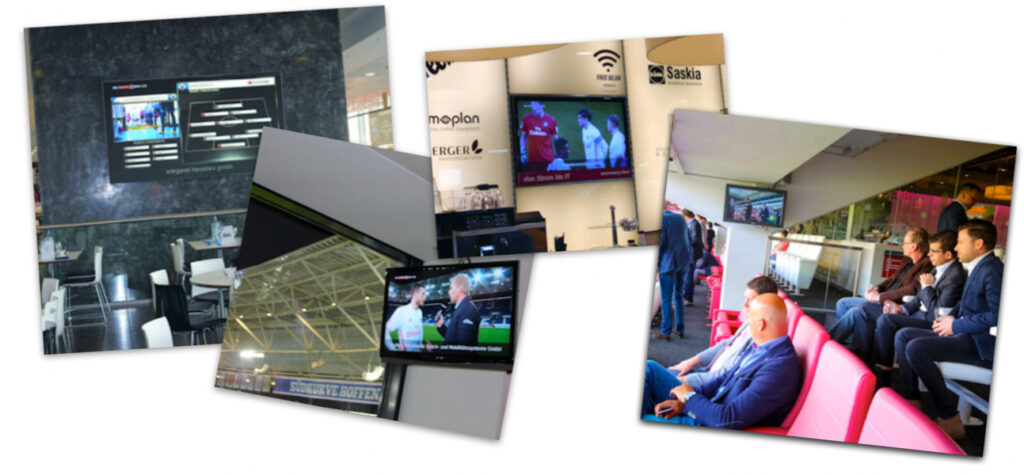

Share this